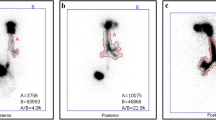Abstract
Purpose. We wanted to demonstrate the utility of the radionuclide salivagram in assessing children whose underlying medical problems suggest that aspiration of oral contents is a factor contributing to otherwise unexplained lung disease or recurrent pneumonias.
Materials and methods. Following sublingual administration of 300 μCi (11.1 MBq) of technetium-99m sulfur colloid in a drop of saline, serial images were obtained for 60 min and evaluated for entrance of tracer into the major airways and lung parenchyma. Thirty-four studies were performed on 31 patients (age: 3 weeks - 16.7 years, mean 5.5 years) with recurrent pneumonias or unexplained lung disease. All had medical conditions, most frequently neurological, predisposing to aspiration.
Results. Pulmonary aspiration was detected in eight patients. All positive studies demonstrated aspirated tracer distal to the tracheal bifurcation, either in bronchi or in bronchi and lung parenchyma. Aspiration was bilateral in six cases. Clearance of aspirated tracer was noted in one patient.
Conclusion. The salivagram is an effective tool for demonstrating aspiration of oral contents and the level to which aspirated fluid penetrates the tracheobronchial tree. Additionally, by allowing for the evaluation of clearance of aspirated tracer, the salivagram may provide information on the status of airway-protective mechanisms.
Similar content being viewed by others
References
Heyman S, Respondek M (1989) Detection of pulmonary aspiration in children by radionuclide “salivagram”. J Nucl Med 30: 697–699
Heyman S (1989) The radionuclide salivagram for detecting the pulmonary aspiration of saliva in an infant. Pediatr Radiol 19: 208–209
Huxley EJ, Viroslav J, Gray WR, Pierce AK (1978) Pharyngeal aspiration in normal adults and patients with depressed consciousness. Am J Med 64: 565–567
Schreiner A (1979) Anaerobic pulmonary infections. Scand J Infect Dis [Suppl] 19: 77–79
Heyman S, Kirkpatrick JA, Winter HS, Treves ST (1979) An improved radionuclide method for the diagnosis of gastroesophageal reflux and aspiration in children (milk scan). Radiology 131: 479–482
Ekberg O, Hilderfors H (1985) Defective closure of the laryngeal vestibule: frequency of pulmonary complications. AJR 145: 1159–1164
Siegel JA, Wu RK, Knight LC, et al (1983) Radiation dose estimates for oral agents used in upper gastrointestinal disease. J Nucl Med 24: 835–837
Dodds WJ, Logemann JA, Stewart ET (1990) Radiological assessment of abnormal oral and pharyngeal phases of swallowing. AJR 154: 965–974
Dodds WJ, Stewart ET, Logemann JA (1990) Physiology and radiology of the normal oral and pharyngeal phases of swallowing. AJR 154: 953–963
Author information
Authors and Affiliations
Rights and permissions
About this article
Cite this article
Bar-Sever, Z., Connolly, L.P. & Treves, S.T. The radionuclide salivagram in children with pulmonary disease and a high risk of aspiration. Pediatr Radiol 25 (Suppl 1), S180–S183 (1995). https://doi.org/10.1007/BF03545624
Received:
Accepted:
Published:
Issue Date:
DOI: https://doi.org/10.1007/BF03545624




